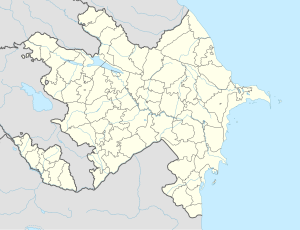Şahtaxtı
Şahtaxtı | |
|---|---|
Municipality | |
| Coordinates: 39°22′19″N 45°05′46″E / 39.37194°N 45.09611°E | |
| Country | |
| Autonomous republic | Nakhchivan |
| District | Kangarli |
| Population (2005) | |
• Total | 3,100 |
| Time zone | UTC+4 (AZT) |
Şahtaxtı, historically Arshat-Arkashat (Template:Lang-hy), is a village and municipality in the Kangarli District of Nakhichevan, Azerbaijan. The village is located in the Sharur plain, 4.5 km south-west from the regional center. Its population is busy with farming and animal husbandry.
Documents of the U.S. Department of State suggest a historically heavy Armenian presence in the area; the ancient city of Arshat-Arkashat had been founded in the third century BC and served as a residence of Armenian kings. Tombs and cuneiforms of the Van kingdom, dated to the third to second centuries BC had been also discovered on its territory.[1]
Today, there are secondary school, kindergarten, cultural house and a medical center in the village. It has a population of 3,100. The medieval monuments of Cinlidere are located in the south-west of the village; in the west, near the Givrag plateau, is the location of Shahbaghi.[2] South of the village lies the city of Poldasht in Iran.
Etymology
The modern settlement was established as a result of the settlement of the Kengerli tribe of Turkic peoples. The area of the location of Alinja fortress was purportedly also called Şahtaxtı in the past. Azerbaijani researchers translate this place name as "smooth plain in the foothills of the mountain".[3]
Ancient settlement

Nearby is the site of an ancient settlement of the Bronze and first Iron Age; it is located south-west from the village. According to findings, the earliest settlement in the area was founded in the third millennium BC.[2]
Documents of the U.S. Department of State suggest a historically heavy Armenian presence in the area; the ancient city of Arshat-Arkashat (Template:Lang-hy) had been founded in the third century BC and served as a residence of Armenian kings. Tombs and cuneiforms of the Van kingdom, dated to the third to second centuries BC had been also discovered on its territory.[4]
The area is about 2 hectares. As a result of wear and tear, the remains of the monuments and the destroyed stone buildings need to be monitored. The thickness of the cultural layer, which was defined at the result of researches (1936 and 1979-90), is 3–4.5 m. The castle walls, built of large stones (2.2–2.6 m in width, 1,2-2,5 m in height) and remains of the residential buildings are very interesting.
During the 15-14th centuries BC, Shahtakhti became a type of a fortress-city settlement, and has been the center of a large tribal unions of Nakhichevan. The pottery, metalwork, jewellery etc. were highly developed in Shahtakhti. A rich painted ceramics, cylindrical seals (15-14 centuries BC), and the exquisite decorative patterns found here show that the Shahtakhti was in close contact with the ancient cultural centers of the Middle East.
Pink, gray and black pottery, ornaments, stone tools and osteologic remains were found in the settlement.
Notable natives
- Hamid bey Shahtakhtinski - Minister of Education and Religious Affairs of Azerbaijan Democratic Republic
- Behbud Agha Shakhtakhtinski — People's Commissar of Justice of Azerbaijan SSR, Chairman of the Council of People's Commissars of the Nakhichevan SSR (1922).[5]
- Huseyin Ibrahimov — writer, People's Writer of Azerbaijan (1998), Chairman of the Supreme Council of Nakhichevan ASSR (1963–71), Minister of Culture of the Nakhichevan ASSR (1970–76).[6]
- Zarifa Aliyeva — ophthalmologist, academician of the Azerbaijan National Academy of Sciences, professor; daughter of the People's Commissar of Health of Azerbaijan SSR, First Secretary of the Dagestan Regional Committee of the Communist Party, Aziz Aliyev, wife of the President of Azerbaijan Heydar Aliyev and the mother of the President of Azerbaijan Ilham Aliyev.[7]
References
- ^ "New Page 1". gmakhmourian.research.sci.am. Retrieved 2021-04-25.
- ^ a b ANAS, Azerbaijan National Academy of Sciences (2005). Nakhchivan Encyclopedia. Vol. volume II. Baku: ANAS. p. 291. ISBN 5-8066-1468-9.
{{cite book}}:|volume=has extra text (help) - ^ Encyclopedic dictionary of Azerbaijan toponyms. In two volumes. Volume I. p. 304. Baku: "East-West". 2007. ISBN 978-9952-34-155-3.
- ^ "New Page 1". gmakhmourian.research.sci.am. Retrieved 2021-04-25.
- ^ "Шахтахтинский Бейбут Ага". Справочник по истории Коммунистической партии и Советского Союза 1898 - 1991.
- ^ "ИБРАГИМОВ, Гусейн Мамедали оглы". Литературная энциклопедия.
- ^ "Bu gün məşhur oftalmoloq alim, akademik Zərifə xanım Əliyevanın doğum günüdür". «Trend». 2010-04-28.



